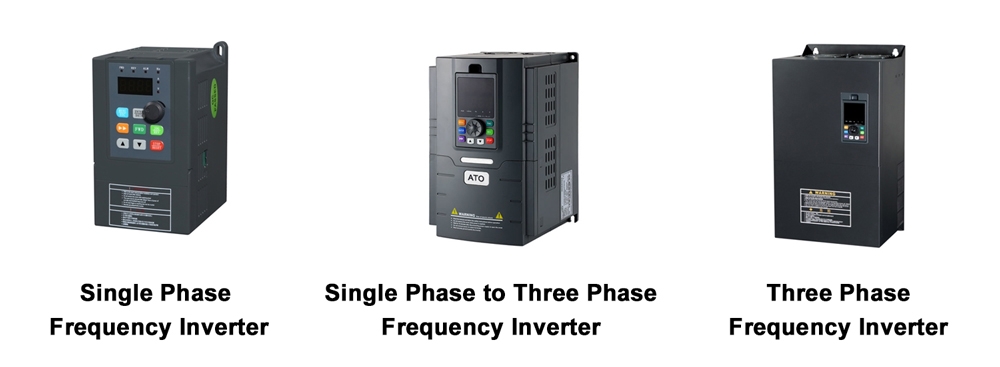Frequency inverter is the application of frequency inversion technology and microelectronics technology, by changing the frequency of the motor operating power supply to control the AC motor power control equipment. The frequency inverter is categorized according to the aspect of the speed regulation system, there are various methods, and the following has Inverter shop for you to introduce the types of frequency converter.
A frequency inverter, also known as an AC frequency converter or AC speed regulator, is a kind of electronic equipment, used to control the speed of the motor, realize energy saving, and precise control, and improve the degree of industrial automation. Frequency inverters are widely used in various industrial sectors such as manufacturing, construction, water treatment and mining. The different types of frequency inverters fulfill the needs of different applications.
Classification According to Input Voltage Level
Frequency inverters can be divided into low-voltage frequency inverters and high-voltage frequency inverters according to the input voltage level, low-voltage frequency inverters domestic common single-phase frequency inverters, and three-phase frequency inverters. High-voltage frequency converters commonly have 6 kV, and 10 kV transformers and the control mode is generally according to the high and low-high frequency converter or high-high frequency converter way to transform.
According to the Current Way
- AC Frequency Inverter: AC frequency inverter is the most common type, used to control the speed of AC motor. The frequency inverter adjusts the running speed of the motor by changing the input voltage and frequency of the motor. AC inverters are widely used in manufacturing, water treatment and construction industries to improve efficiency and reduce energy consumption. The working principle of AC frequency inverters is based on PWM (Pulse Width Modulation) technology.
The AC frequency inverter receives AC power from the grid, rectifies it into DC power, and then converts the DC power back into AC power through an inverter. By varying the output frequency and voltage of the frequency converter, the frequency inverter can precisely control the speed of the motor. In addition, AC frequency inverters can provide additional features such as overload protection, start and stop control. - DC Frequency Inverter: DC inverters are another type that is mainly used to control the speed of DC motors. Although DC inverters are not as common as AC inverters in some applications, they are still very useful in some specific situations. DC inverters control the speed of a motor by varying its input voltage and current. DC frequency converters are often used in applications that require high precision control, such as laboratory equipment and some specialized industrial applications.
According to the Way of Power Supply
Single-phase Inverters: Single-phase frequency inverters are suitable for applications powered by a single-phase supply, such as household appliances and small motors. Single-phase frequency inverters are usually used for low-power applications and are suitable for small motors that require precise control. Suitable for applications powered by single-phase mains. Suitable for small motors such as household appliances.

Three-phase Inverters: Three-phase frequency inverters are suitable for applications powered by a three-phase mains supply, such as in industrial and commercial areas. Three-phase frequency converters are typically used for medium to high-power applications and can precisely control the speed and torque of large motors. Suitable for applications powered by three-phase power sources, such as industrial equipment and large motors, the frequency converters are ideal for high-power applications.
By Converter Link
AC-AC Frequency Inverters: Convert AC DC with fixed frequency into AC with continuously adjustable frequency and voltage. The main advantage is that there is no intermediate link and the conversion efficiency is high. However, the continuously adjustable frequency range is narrow, through the rated frequency of 1/2 or less, mainly for power traction and other large-capacity low-speed drag systems.
AC-DC-AC Frequency Inverter: first rectify the AC power with fixed frequency into DC power, and then invert the DC power into AC power with continuously adjustable frequency. As the link of reversing DC into AC is easier to control, it has obvious advantages in frequency adjustment range and improvement of motor characteristics after frequency conversion, etc., and is the widely used frequency conversion method at present.
According to the Energy Storage Method of the DC Link
Current-type Frequency Inverter: Characterized by the intermediate DC link using a large inductor as the energy storage link, buffer reactive power, i.e., choke current changes, so that the voltage is close to a sinusoidal waveform, due to the DC internal resistance is larger, so it is called the current source type frequency inverter (current type). The characteristic (advantage) of the current frequency inverter is that it can choke the frequent and rapid change of load current. It is often used on occasions where the load current varies greatly.
Voltage Type Frequency Inverter: Characterized by the intermediate DC link of the energy storage element using a large capacitor, the reactive power of the load will be buffered by it, the DC voltage is relatively smooth, the DC power supply internal resistance is small, equivalent to the voltage source, so it is known as the voltage type frequency converter, often used in the load voltage changes in the occasion.
According to the Use

- General Frequency Converter: It refers to the frequency inverter that can be used with ordinary cage-type asynchronous motor, can adapt to various loads of different nature, and has a variety of optional functions.
- High-performance Dedicated Frequency Inverter: High-performance dedicated inverter is mainly used in the system with higher requirements for motor control. Compared with general-purpose inverters, most of the high-performance dedicated inverters adopt vector control mode, and the driving object is usually the special motor specified by the inverter manufacturer.
- High-frequency Inverter: In ultra-precision machining and high-performance machinery, high-speed motors are often used. In order to meet the driving requirements of these high-speed motors, high-frequency inverters adopting the PAM (Pulse Amplitude Modulation) control mode have appeared, and the output frequency of the frequency inverter can reach 3kHz.
- IGBT Frequency Inverter: IGBT frequency inverters use insulated gate bipolar transistors (IGBTs) as power-switching devices. IGBTs have high voltage tolerance and high switching speeds, making inverters ideal for high-power applications. IGBT frequency converters can achieve efficient power conversion and are widely used in industrial drives and motor control.
- MOSFET Frequency Inverters: MOSFET frequency converters use metal-oxide-semiconductor field-effect transistors as the power-switching device.MOSFETs have low on-resistance and fast switching characteristics, which makes them suitable for some applications that require high-frequency switching. These frequency converters are typically used in low-power applications and high-frequency applications.
Frequency converters are indispensable devices in modern industrial automation and energy management. Different types of frequency inverters are suitable for different applications. Understanding the types of frequency inverters and how they work, as well as the uses of frequency inverters, helps in choosing the best solution for a particular application. The widespread use of good quality frequency inverters has brought greater efficiency and energy savings to various industries, helping to promote sustainable industrial and social development.
